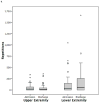Movement repetitions in physical and occupational therapy during spinal cord injury rehabilitation
- PMID: 27752057
- PMCID: PMC5292050
- DOI: 10.1038/sc.2016.129
Movement repetitions in physical and occupational therapy during spinal cord injury rehabilitation
Abstract
Study design: Longitudinal observational study.
Objective: To quantify the amount of upper- and lower-extremity movement repetitions (that is, voluntary movements as part of a functional task or specific motion) occurring during inpatient spinal cord injury (SCI), physical (PT) and occupational therapy (OT), and examine changes over the inpatient rehabilitation stay.
Setting: Two stand-alone inpatient SCI rehabilitation centers.
Methods: Participants: A total of 103 patients were recruited through consecutive admissions to SCI rehabilitation.
Interventions: Trained assistants observed therapy sessions and obtained clinical outcome measures in the second week following admission and in the second to last week before discharge.
Main outcome measures: PT and OT time, upper- and lower-extremity repetitions and changes in these outcomes over the course of rehabilitation stay.
Results: We observed 561 PT and 347 OT sessions. Therapeutic time comprised two-thirds of total therapy time. Summed over PT and OT, the median upper-extremity repetitions in patients with paraplegia were 7 repetitions and in patients with tetraplegia, 42 repetitions. Lower-extremity repetitions and steps primarily occurred in ambulatory patients and amounted to 218 and 115, respectively (summed over PT and OT sessions at discharge). Wilcoxon-signed rank tests revealed that most repetition variables did not change significantly over the inpatient rehabilitation stay. In contrast, clinical outcomes for the arm and leg improved over this time period.
Conclusions: Repetitions of upper- and lower-extremity movements are markedly low during PT and OT sessions. Despite improvements in clinical outcomes, there was no significant increase in movement repetitions over the course of inpatient rehabilitation stay.
Conflict of interest statement
The authors declare that there are no competing financial interests in relation to the work described.
Figures



References
-
- Teeter L, Gassaway J, Taylor S, LaBarbera J, McDowell S, Backus DD, et al. Relationship of physical therapy inpatient rehabilitation interventions and patient characteristics to outcomes following spinal cord injury: The SCIRehab project. The Journal of Spinal Cord Medicine. 2012 Nov;35(6):503–26. - PMC - PubMed
-
- Ozelie R, Gassaway J, Buchman E, Thimmaiah D, Heisler L, Cantoni K, et al. Relationship of occupational therapy inpatient rehabilitation interventions and patient characteristics to outcomes following spinal cord injury: The SCIRehab Project. The Journal of Spinal Cord Medicine. 2012 Nov;35(6):527–46. - PMC - PubMed
-
- Heinemann AW, Hamilton B, Linacre JM, Wright BD, Granger C. Functional Status and Therapeutic Intensity During Inpatient Rehabilitation. American Journal of Physical Medicine & Rehabilitation. 1995;74(4):315–26. - PubMed
-
- van Langeveld SA, Post MW, van Asbeck FW, Gregory M, Halvorsen A, Rijken H, et al. Comparing Content of Therapy for People With a Spinal Cord Injury in Postacute Inpatient Rehabilitation in Australia, Norway, and the Netherlands. Physical Therapy. 2011 Feb;91(2):210–24. - PubMed
Publication types
MeSH terms
Grants and funding
LinkOut - more resources
Full Text Sources
Other Literature Sources
Medical

